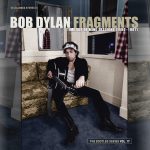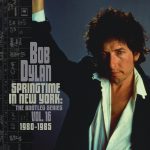Bob Dylan & the Band: Finally, Everything’s Out of the Basement
“When I saw the UPS guy drive up to my house, I went to the door and waited for him to walk up,” wrote one buyer of this album, on Amazon’s website. “He smiled and said, ‘I hope you haven’t been waiting too long.’ I said, ‘Only about 44 years.’”
Actually it’s been 47 years, but who’s counting? The point is that Dylan fans have been waiting decades for this material, some of which has been fed to us in dribs and drabs and most of which has never previously seen an official release.
We got our first taste of the so-called Basement Tapes—which, incidentally, were not all recorded in a basement—shortly after Dylan and the Band completed them in the fall of 1967. The Band included their own versions of several songs from the sessions on 1968’s Music from Big Pink, their classic debut LP. And many other artists soon issued cover versions of Basement Tapes material, among them Julie Driscoll with Brian Auger & the Trinity (“This Wheel’s on Fire”), Peter, Paul & Mary (“Too Much of Nothing”), the Byrds (“You Ain’t Goin’ Nowhere”), the Tremeloes and the Box Tops (“I Shall Be Released”) and Manfred Mann (“Quinn the Eskimo” and “Please Mrs. Henry,” though a member of Manfred Mann erroneously states in the liner notes here that it didn’t issue the latter track until 1998). Then there was 1969’s Great White Wonder, which pretty much launched the bootleg album industry and included a handful of tracks from the original sessions.
Dylan, meanwhile, issued none of this material in the years after it was recorded. Astonishingly, considering how good some of it is, he had no intention of ever doing so.
Finally, though, the many bootlegs and covers and a ton of press—including an editorial by Rolling Stone publisher Jann Wenner, headlined “Dylan’s Basement Tape Should Be Released”—prompted the singer and his record label to have second thoughts. In 1975, they issued a two-CD collection that contained 16 key tracks from the sessions. (The set also featured eight songs recorded by the Band without Dylan between 1967 and 1975; the new package omits these.)
You might think that would be the end of it, but some fans, having heard, or at least heard of, additional tracks, wanted more. And now—nearly half a century after Dylan and the Band recorded them—we have The Basement Tapes Complete, which features a whopping 140 songs (including two on a hidden track at the end of the last disc). The six-CD package incorporates a beautifully designed 40-page book with terrific essays about the music, a detailed track listing and reproductions of photos and press clippings. A 122-page second book offers many more photos of Dylan and the Band, more press clippings and assorted other memorabilia. The books, both hardcover, are housed in a sturdy slipcase that is lined on the inside with a map of the Woodstock area—just one of many examples of the designers’ attention to detail.
While the packaging is impressive, it is of course those 140 songs—some uncovered only recently and all but about 20 not been previously released officially or at all—that matter most. According to the liner notes, they include everything from the 1967 sessions except “those few instances where the audio is so decayed as to be unlistenable.” (The sound quality isn’t great on all of what is here, either, but thanks largely to the Band’s Garth Hudson, who helped restore the tapes, it’s much improved from what we heard on the 1975 release; the exception is disc six, which departs from the chronological program format to collect the material with the most marginal audio.)
While the 1975 release includes many of the most important Dylan compositions, this much larger new collection is far better and more illuminating. It sheds fresh light on the creative process, influences and late-60s mindset of Dylan, whose Self-Portrait, John Wesley Harding and Nashville Skyline probably wouldn’t have surprised so many people if they’d heard these tracks first.
He wrote (or in a few cases cowrote) about two-thirds of the songs on The Basement Tapes Complete and they’re a diverse lot, to put it mildly—everything from goofy novelties like “Kickin’ My Dog Around” and “See You Later Allen Ginsberg” to the tongue-in-cheek fifties rock of “I’m Your Teenage Prayer” to the stunning Americana classics that first saw light of day on Music from Big Pink and 1975’s original Basement Tapes: the mournful “Tears of Rage,” the eloquent “I Shall Be Released,” the joyful “You Ain’t Goin’ Nowhere” and the rest. And then there are the classics that haven’t previously been officially released—“I’m Not There,” for example, and the beautifully sung “Young But Daily Growing.” Also here are radically different versions of “Blowin’ in the Wind,” “One Too Many Mornings” and “It Ain’t Me, Babe.”
The non-originals, which appear mostly on the first two discs (which are also notable for the frequent absence of Band drummer/vocalist Levon Helm), cover at least as much territory as the Dylan compositions. He draws on everything from country (Hank Williams’s “You Win Again”) and blues (John Lee Hooker’s “Tupelo”) to soul (Curtis Mayfield’s “People Get Ready”) and folk (Ian Tyson’s “Four Strong Winds”). It may initially seem strange to hear Dylan singing—with what seems like genuine affection—songs that have been recorded by the likes of the Fleetwoods (“Mr. Blue,” “Confidential”) and the Rays (“Silhouettes”), but if you’ve listened to his Theme Time Radio Hour, you know how wide-ranging his tastes can be.
Dylan and the Band’s approach to this music is as fascinating as the music itself. In 1967, the Beatles sought multitracked studio perfection on Sgt. Pepper’s Lonely Hearts Club Band and Phil Spector was still obsessively polishing his “little symphonies for the kids.” But The Basement Tapes capture something else entirely. Dylan and the Band wander all over the musical map—covering seemingly everything but the fashionable sounds and subjects of the time—and they do so for the sheer fun of it, not worrying about how the results might sound to the public because they never intend for them to reach the public. There are aborted half-songs, failed experiments and rough edges all over the place, but sheer joy radiates from every track and, somehow, all the imperfections add up to a kind of perfection.
As Sid Griffin notes in one of the package’s excellent essays, “This was the Big Bang of the musical genre we now call alt-country. When you look at the song titles on an ‘Americana’ chart in any trade magazine today, you are seeing The Basement Tapes’ musical grandchildren.”
Indeed, this album is likely to be as important to today’s folk artists and fans as Harry Smith’s Anthology of American Folk Music has been to Dylan and his contemporaries. Don’t miss it.
Jeff Burger (byjeffburger.com) edited Leonard Cohen on Leonard Cohen: Interviews and Encounters and Springsteen on Springsteen: Interviews, Speeches, and Encounters, both published by Chicago Review Press.




